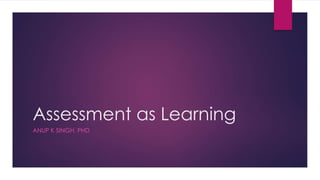
Assessment as learning
- 1. Assessment as Learning ANUP K SINGH, PHD
- 2. Defining Learning and Assessment Learning as a change in knowledge, attitudes, skills and habits Assessment as the assignment of numerals to a phenomenon, content, or behaviour with a view to systematically interpret it Learning is boosted when there is feedback Assessment information is feedback and it provides an opportunity to a learner to improve oneself Sometimes assessment can be as useful as good instruction for learning Timely, detailed, and frequent feedback is essential for high learning The distinction between summative and formative assessment is superficial as both types of assessment can provide feedback
- 3. Assessment and Learning Assessment of learning (Summative assessment, no feedback) Assessment for learning (Formative assessment, feedback) Assessment as learning (Assessment as part and parcel of learning, the primary purpose of assessment becomes learning, while the secondary purpose remains grading)
- 4. The Teacher The Learner The TechnologyThe Context Content Pedagogy Assessment Learning-teaching and Assessment System
- 5. Two Aspects of Assessment Reliability Validity
- 6. Validity of Assessment Validity is defined as the way a measure assesses what is it is supposed to assess What a question, an assignment or a quiz is supposed to measure? It may mean different things to different people Therefore, there is a need for agreement Thus, the criteria for assessment have to be developed. These are also known as rubrics For assessment, rubrics have to operationalised Rubrics can be measured using both ordinal and interval scales and both should be measured for assurance and grading purposes, respectively
- 7. Criterion Based Assessment Just as the content of a course flows from the CLOs, each assessment component and its rubrics should also emanate from CLOs The development of assessment rubrics have to be discussed at BoS and Area level so that their face validity is established Each Rubric can be assessed using three basic levels: Below Expectations; Meets Expectations; and Exceeds Expectations (Let us keep it simple) Each level should have sufficient description of the rubric and expectations Each assessment unit can be evaluated suing 10 point scale The distribution of points among levels can be: Below Expectations (1-3); Meets Expectations (4-7); and Exceeds Expectations (8-10) The whole system should be transparent and the student should know the assessment scheme, including rubrics and their description
- 8. 1. Development of institutional mission 2. Development of programme educational outcomes 3. Development of graduate attributes 4. Development of programme learning outcomes (using feedback from different stakeholders) 5. Designing of student experience through curricular, co-curricular, and extra-curricular activities 6. Mapping of PLOs with different courses (High, medium, low) 7. Mapping of PLOs with different co-curricular and extra-curricular activities 8. Development of course learning outcomes Feedback from Stakeholder Faculty Community Engagement
- 9. 1. Development of course learning outcomes 2. Mapping of CLOs with different sessions 3. Determination of content, pedagogies and assessment rubrics and tools on the basis of CLOs 4. Mapping of CLOs with assessment rubrics and tools 5. Engagement of faculty community in each activity
- 10. Assurance of Learning Indirect Assessment Direct Assessment 1 Student satisfaction survey 2 Alumni learning survey 3 Recruiter surveyIndependent Assessment Embedded Assessment 1 Standardised testing 2 Capstone course 3 Integrated simulation test 4 National level test 5 Pre test-post test evaluation 1 Rubric bases assessment 2 Assessment of student learning on the different levels of a rubric 3 Statistical analysis of student achievement on different rubrics 4 Development of strategies for improving student learning Head and Committee for AoLS
- 11. Rubrics Design, Development and Implementation Criterion based assessment Rubrics have to aligned with both content and assessment Rubrics have to be valid; at least their face validity has to be established In other words, rubrics have to be jointly decided by a group of faculty Rubrics should be both general and specific Rubrics can be changed on the basis of the experience of faculty during assessment Ultimately, rubrics have to focussed on learning through feedback and self-assessment
- 12. Roles, Committees and Responsibilities for AoLS Appointing one person and a committee at the institute level to oversight AoLS Appointing one person for each programme to supervise AoLS Training faculty in AoLS Preparation and documentation of assessment data for each course by course faculty Collection of reports by course coordinator Sampling courses for assessment [For record purposes) Collection and analysis of data Preparation of AoLS report for the subject Discussion of all assessment report in Area/programme/BoS
- 13. Dos and Don’ts in Assurance of Learning Standards Dos Plan it elaborately Conduct faculty training Create appropriate roles and structure Make everything clear to students Improve course and curriculum on the basis of feedback Keep record at individual, programme and institution level Don'ts Equate marking with rubric assessment Develop rubrics without high rigour and community engagement Leave it to an individual faculty. AoLS is the responsibility of the academic community Make it too complex
- 14. Implications of Assessment As Learning Learning is the centre of activities, assessment is the background There should be several and diverse assessment activities Each assessment activity has to be followed by feedback Over a period of time, an instructor should develop and store the examples of different levels of learning for different assessment activities There should be an audit of assessment tools and assessed work from time to time Faculty should be trained in using Assessment As Learning A Senior Professor should lead the initiative so that it gets credence
